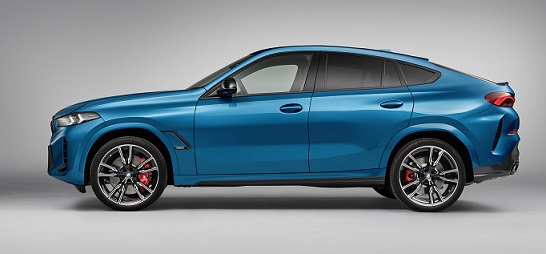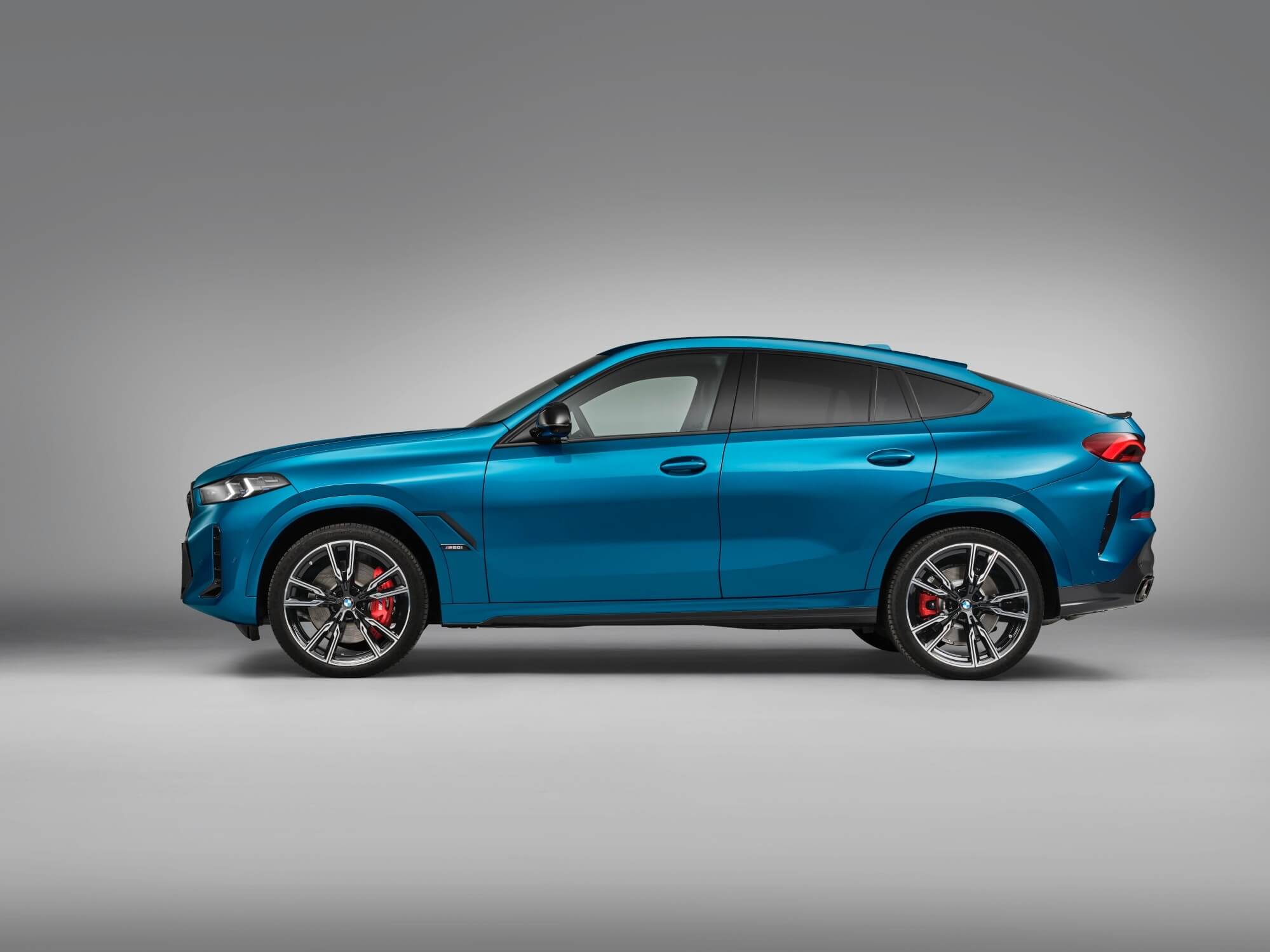Key specs
BMW X6 (SUV) X6 (G06 LCI, facelift 2023) 2023,2024,2025,2026
What is the body type, BMW X6 (G06 LCI, facelift 2023) M60i V8 (530 Hp) MHEV xDrive Steptronic 2023?
SAC, 5 Doors, 5 Seats
How much power, BMW X6 (G06 LCI, facelift 2023) M60i V8 (530 Hp) MHEV xDrive Steptronic 2023?
530 Hp @ 5500-6000 rpm.
120.6 Hp/l
How fast is the car, BMW X6 (G06 LCI, facelift 2023) M60i V8 (530 Hp) MHEV xDrive Steptronic 2023?
250 km/h, Electronically limited 155.34 mph
What is the engine size, BMW X6 (G06 LCI, facelift 2023) M60i V8 (530 Hp) MHEV xDrive Steptronic 2023?
4395 cm3
268.2 cu. in.
How many cylinders, BMW X6 (G06 LCI, facelift 2023) M60i V8 (530 Hp) MHEV xDrive Steptronic 2023?
8,
V-engine
What is the drivetrain, BMW X6 (G06 LCI, facelift 2023) M60i V8 (530 Hp) MHEV xDrive Steptronic 2023?
All wheel drive (4x4),
How long is this vehicle, BMW X6 (G06 LCI, facelift 2023) M60i V8 (530 Hp) MHEV xDrive Steptronic 2023?
4960 mm
195.28 in.
How wide is the vehicle, BMW X6 (G06 LCI, facelift 2023) M60i V8 (530 Hp) MHEV xDrive Steptronic 2023?
2004 mm
78.9 in.
What is the curb weight, BMW X6 (G06 LCI, facelift 2023) M60i V8 (530 Hp) MHEV xDrive Steptronic 2023?
2315 kg
5103.7 lbs.
BMW X6 (SUV) X6 (G06 LCI, facelift 2023) 2023,2024,2025,2026 Specs
General information
| Brand |
BMW |
| Model |
X6 (SUV) |
| Version |
X6 (G06 LCI, facelift 2023) |
| Engine version |
M60i V8 (530 Hp) MHEV xDrive Steptronic |
| Year production start |
2023 |
| Vehicle type |
SAC |
| Horsepower RPM |
530 Hp @ 5500-6000 rpm. |
| Acceleration 0 - 100 kmh sec |
4.3 sec |
| Curb weight kg -lbs total |
2315 kg
5103.7 lbs.
|
| Overall length mm - inch |
4960 mm
195.28 in.
|
| Doors |
5 |
| Top Speed |
250 km/h, Electronically limited 155.34 mph |
Engine specs
| Designation model |
S68 |
| Cam configuration |
Double-VANOS, VALVETRONIC
|
| Cylinders |
8 |
| Position of cylinders |
V-engine |
| Displacement (liters) |
4395 cm3
268.2 cu. in.
|
| Eng. horsepower RPM |
530 Hp @ 5500-6000 rpm.
|
| Horsepower per litre |
120.6 Hp/l
|
| Weight / horsepower kg/hp - hp/tons |
4.4 kg/Hp
228.9 Hp/tonne
|
| Weight / torque kg/Nm - Nm/tons |
3.1 kg/Nm, 324 Nm/tonne
3.1 kg/Nm
324 Nm/tonne
|
| Torque Nm RPM lb-ft RPM |
750 Nm @ 1800-4600 rpm.
553.17 lb.-ft. @ 1800-4600 rpm.
|
| Bore (mm in) |
89 mm
3.5 in.
|
| Stroke (mm in) |
88.3 mm
3.48 in.
|
| Compression ratio |
10.5 |
| Fuel type |
Petrol (Gasoline) |
| Valvetrain |
4 |
| Engine aspiration |
Twin-power turbo, Intercooler |
| Emission certification |
Euro 6d
|
| Powertrain architecture |
MHEV (Mild Hybrid Electric Vehicle, power-assist hybrid, battery-assisted hybrid vehicles, BAHV) |
| Electric motor power |
12 Hp
|
| Electric motor torque |
200 Nm 147.51 lb.-ft.
|
| Engine location |
Front, Longitudinal
|
Transmission and Drive system
| Drive configuration |
All wheel drive (4x4)
|
Brakes
| Front brakes |
Ventilated discs |
| Rear brakes |
Ventilated discs |
| Anti-lock brake system |
ABS (Anti-lock braking system) |
Steering
| Steering type |
Steering rack and pinion |
| Turning diameter m - ft |
12.0 m
39.37 ft.
|
Suspension
| Front suspension |
Double wishbone, Air Suspension - Optional |
| Rear suspension |
Independent multi-link suspension, Air Suspension - Optional |
Wheels & Tyres
| Wheels size |
Front wheel tires: 275/40 R21 107Y XL
|
| Wheels rims |
Front wheel rims: 9.5J x 21 |
Passenger
| Passengers seats |
5 |
| Trunk space min liter | cu. Ft. |
580 l
20.48 cu. ft.
|
| Trunk space max liter | cu. Ft. |
1530 l
54.03 cu. ft.
|
| Roof load load kg lbs |
100 kg
220.46 lbs.
|
Dimensions
| Overall length mm - inch |
4960 mm
195.28 in.
|
| Overall width mm -inch |
2004 mm
78.9 in.
|
| Overall height mm -inch |
1700 mm
66.93 in.
|
| Wheelbase mm - inch |
2975 mm
117.13 in.
|
| Track width front mm - inch |
1679 mm
66.1 in.
|
| Track width rear mm - inch |
1688 mm
66.46 in.
|
| Coefficient of drag |
0.35
|
Weights
| Curb weight kg -lbs total |
2315 kg
5103.7 lbs.
|
| Gross weight kg -lbs total |
3085 kg
6801.26 lbs.
|
| Capacities kg - lbs |
770 kg
1697.56 lbs.
|
| Fuel tank liters | gallons |
83 l
21.93 US gal | 18.26 UK gal
|
Fuel economy
| Combined fuel consumption (WLTP) |
11.4-12.3 l/100 km 20.63 - 19.12 US mpg |
Engine type
8 CYLINDER V-Engine
https://www.thecarspec.net/components/engine/8-cylinders-v


